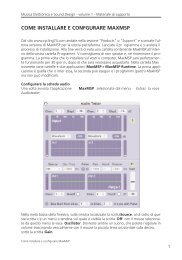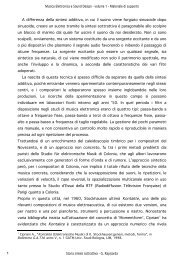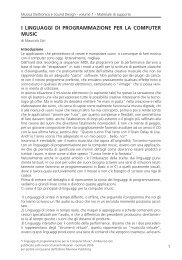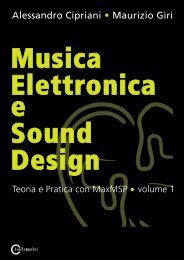programming with max/msp - Virtual Sound
programming with max/msp - Virtual Sound
programming with max/msp - Virtual Sound
Create successful ePaper yourself
Turn your PDF publications into a flip-book with our unique Google optimized e-Paper software.
Chapter 3T - Noise generators, filters, and subtractive synthesis<br />
> Filtered pseudo-random sample generators<br />
In this kind of approach, the signal produced is filtered using a lowpass<br />
filter. We will speak further of this kind of generator in the section<br />
dedicated to lowpass filters.<br />
INTERACTIVE EXAMPLE 3A – NOISE GENERATORS – PRESETS 1-4<br />
OSCILLATORS AND OTHER SIGNAL GENERATORS<br />
In Section 1.2T, we examined the “classic” waveforms that are often found<br />
in synthesizers, such as the square wave, the sawtooth wave, and the triangle<br />
wave. Section 2.1T explained how these waveforms, when geometrically perfect<br />
(perfect squares, triangles, etc.), contain an infinite number of frequency components.<br />
The presence of infinitely large numbers of components, however, causes<br />
nasty problems when producing digital sound, since an audio interface cannot<br />
reproduce frequencies above half of its sampling rate. 3 (We will discuss this topic<br />
in much greater detail in Chapter 5.) When you attempt to digitally reproduce<br />
a sound that contains component frequencies above the threshold for a given<br />
audio interface, undesired components will appear, which are almost always<br />
non-harmonic. To avoid this problem, band-limited oscillators are often used<br />
in digital music. Such oscillators, which produce the classic waveforms, are built<br />
so that their component frequencies never rise above half of the sampling rate.<br />
The sounds generated by this kind of oscillator therefore make a good point of<br />
departure for creating sonorities appropriate for filtering, and as a result, they are<br />
the primary source of sound in synthesizers that focus on subtractive synthesis.<br />
In Section 3.5 we will analyze the structure of a typical subtractive synthesizer.<br />
It is, of course, also possible to perform subtractive synthesis using synthetic<br />
sounds, rich in partials, that have been realized using other techniques such as<br />
non-linear synthesis or physical modeling. We will cover these approaches in<br />
following chapters.<br />
FILTERING SAMPLED SOUNDS<br />
Beyond subtractive synthesis, one of the everyday uses of filters and equalizers<br />
is to modify sampled sounds. Unlike white noise, which contains all frequencies<br />
at a constant amplitude, a sampled sound contains a limited number of<br />
frequencies, and the amplitude relationships between components can vary<br />
from sound to sound. It is therefore advisable, before filtering, to be conscious<br />
of the frequency content of a sound to be processed.<br />
3 It is for this reason that sampling rate of an audio interface is almost always more than twice the<br />
<strong>max</strong>imum audible frequency for humans.<br />
from “Electronic Music and <strong>Sound</strong> Design” Vol. 1 by Alessandro Cipriani and Maurizio Giri<br />
© ConTempoNet 2010 - All rights reserved<br />
8<br />
3T<br />
299







